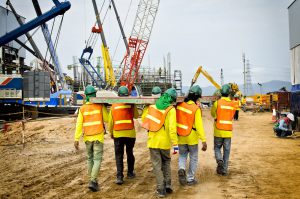Date: 11-Apr-2017
It was reported that the construction sector is expected to grow by eight per cent to RM170 billion this year, boosted by the numerous mega infrastructure projects in the country, the Construction Industry Development Board (CIDB) said.
 CIDB chief executive Datuk Ir Ahmad Asri Abdul Hamid said on Tuesday projects such as the Refinery and Petrochemical Integrated Development project in Johor, Mass Rapid Transit Two in the Klang Valley and the Pan Borneo Highway connecting Sabah and Sarawak, would continue to drive demand in the sector.
CIDB chief executive Datuk Ir Ahmad Asri Abdul Hamid said on Tuesday projects such as the Refinery and Petrochemical Integrated Development project in Johor, Mass Rapid Transit Two in the Klang Valley and the Pan Borneo Highway connecting Sabah and Sarawak, would continue to drive demand in the sector.
“Construction growth was 8.2 per cent, or RM140 billion in 2015 and 7.4 per cent, or RM166 billion last year,” he told a press conference after the Eighth Malaysian Construction Summit, officiated by Works Minister Datuk Seri Fadilah Yusof, here today.
Ahmad Asri said the construction industry achieved an astounding average growth of 11 per cent during the 10th Malaysia Plan, while surpassing the performance of other economic sectors in the country.
He said in terms of construction volume, the value increased from RM140 billion involving 7,455 projects in 2015, to RM166.4 billion for 6,305 projects in 2016.
Only 29.1 per cent or RM48.5 million of the projects in 2016 were by the public sector, while 70.9 per cent or RM117.9 billion came from the private sector.
“The construction industry’s growth last year was very much driven by infrastructure projects, which accounted for 49.7 per cent (RM82.7 billion) of the total.
“The second highest contributor was residential projects, which accounted for 23 per cent (RM38.3 billion), followed by non-residential construction at 22.5 per cent (RM37.4 billion),” he said.
Meanwhile, Fadilah said the government was looking to introduce a Malaysian standard code of practice, outlining the guidelines for temporary construction site workers’ amenities.
It is expected to be included in a new Act to be tabled by the Human Resources Ministry next year.
He said this standard, in line with international practice, was already being practiced by big construction companies here, and the government would now be looking at the small and medium-sized construction players.
“We are continuously engaging with industry players to ensure this will not be a burden.
“One suggestion is for small and medium-sized construction companies to have shared facilities for workers to manage costs,” he added.


